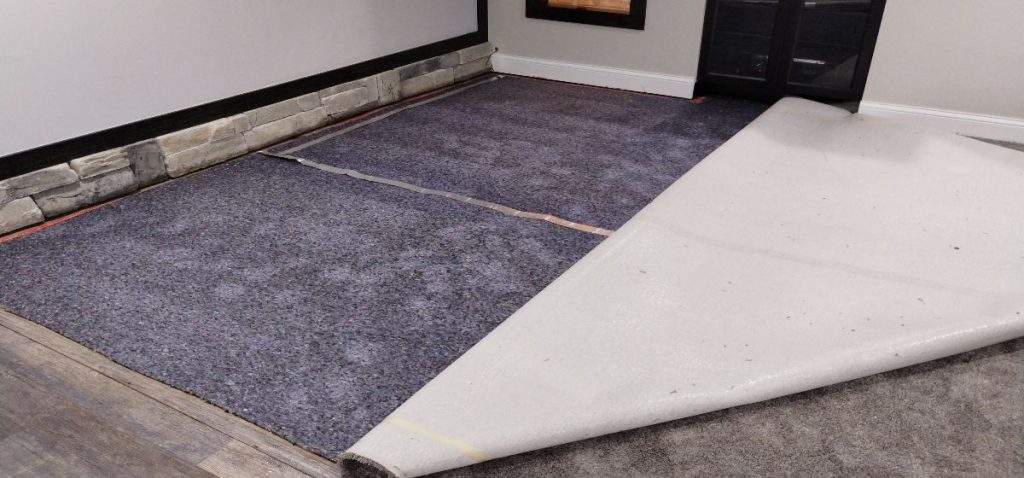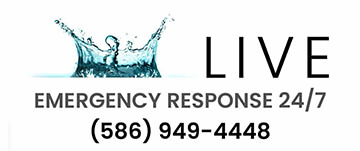
CAN WET PAD BE REUSED AFTER WATER GETS TO IT?
Guidelines on wet carpet Pad Restoration & Removal
Often in finished basements water from a floor drain, sump well or foundation crack will get to a section of carpet and pad. The obvious concerns is can wet carpet pad be restored after flood damage? This article seeks to answer this question by providing objective guidance that comes from the IICRC Standard & Reference guide S-500 publication for water damage restoration. These instructions will allow you to implement the same practices, a certified restoration company would.
The property restoration industry appeals to authoritative literature crafted by these industry specialist, that help keep homes safe from health related concerns. Wet carpet pad is one of those materials known to lead to a wide range of problems, if not managed correctly. There are issues with permanent pungent smells, water staining that wicks into the carpet itself and the dreaded development of mold growth.
2 Types of Water Requiring Padding Removal
Everyone knows when carpet pad gets wet after a flooding issue there is an unnatural environment needing a remedy. There are 2 types of water that always require removal of wet pad, because the level of contamination is great. Water from a ground water source and water from a sanitary system.
1. WATER FROM A GROUND WATER SOURCE
Ground water is teaming with microorganisms, germs, microbes and a host of other harmful chemicals and organic compounds. This water is alive with an eco system that is eager to take residency beneath your carpet where once wet padding resided. After ground water is absorbed into padding, it is beyond the scope of restoration as it will always be a potential health risk to humans. The answer must be an emphatic YES! when questioning, “Is carpet padding ruined if it gets wet? when it is from ground water.
2. WATER FROM A SEWAGE SOURCE
This type of water comes into homes from sewer floor drains, sewers, toilet bowl overflows, broken sewer lines and backups. The high degree of contamination makes the condition of the home uninhabitable, until remediation efforts have been made to assure safety. Sewage is the worse-case-scenario a home can experience when it comes to flood damage. In such conditions it is wise to examine the benefits of professional sewer backup restoration
Not only does the wet carpet pad need to be removed after this type flood damage, but the carpet as well. These materials have become unsanitary beyond the scope of restoring safety and must be completely removed from the property. The sub-floor in many cases will need to be replaced if it is plywood and even concrete will require disinfecting and drying service.
FACTORS THAT DETERMINE IF RESTORATION IS AN OPTION
Carpet Pad Usefulness after Flooding
Typically it is best to remove wet pad once it gets wet, but there is an exception to the rule. Only if all these these relevant circumstances exist at once should wet carpet pad be considered for restoration.
- MINIMAL SIZE AREA IS WET. This is an area of wet pad less than maybe 50 sq. ft. This area is capable of being safety restored with ample air movement, aided by a small dehumidifier. In situations such as complete rooms being saturated it is recommended to consult a professional restoration firm so you don’t end up with a mold damaged environment.
- WATER SOURCE IF FRESH MUNICIPLE WATER. This means the water came from a pure source such as a plumbing supply line, sink over flow and the like. Water from floor drains, foundation leaks and other sources can look clear but are recognized as sources for mold, germs and microorganisms. All these will lead to complications easily avoided with removal and replacement.
- WET PAD CAN BE DIRECTLY EXPOSED TO AIR MOVEMENT. This can often eliminate wet pad that is in the middle of a large room or buried under many pieces of heavy furniture. Wet pad requires an air mover placed under the carpet, but on top of the pad itself to run for several days. Unless you are willing to move all the furniture and cut some carpet to allow for the placement of an air mover, it will remain wet, leading to the difficulties previously described.
- IF THE PAD DOESN’T HAVE A PLASTIC SHEATH ON ONE SIDE. Some manufacturers of carpet pad place a thick plastic sheath on one side often calling their product, “spill guard” or “child-proof”. This type pad is ideal on a main floor where spills and pet accidents can force liquids to get to pads from the top down. The plastic sheath allows for the liquid to remain suspended on the plastic for easy cleanup. However, if the water came from the bottom up as is the case in most basement flooding, water will remain trapped. In this case removal is required as water will languish for multiple days eventually introducing offensive and permanent odors. If the pad is heavily saturated and has a plastic sheath you should consider contacting the professionals for water removal emergency service.
- IF PAD HAS ONLY BEEN WET FOR 24 HOURS. Because water goes from one state of being or (level of contamination) to a worse state each 24 hours, 1 day is the limit on pad remaining wet. If you are to consider restoring the wet carpet pad, the water damage must have recently occurred from a fresh water source. The (EPA) Environmental Protection Agency advises immediate action when carpet with pad gets wet. Ideally, you want to fully dry and restore the pad in 48 hours or less. Mold growth and stubborn odors can become a real concern when attempting to dry a carpet that needs replacing instead of drying.
Restoring Wet Carpet Pad after Flood Damage
If your unique set of circumstances allow for all 5 key factors described above to be valid, only then should restoring wet pad be a consideration.
Here are several tools you will need:
- GLOVES to keep hands safe from being cut from the sharp tackles strip that was used to secure carpet, during original installation.
- PLIERS to lift the carpet from the tackles strip, without tearing carpet.
- UTILITY KNIFE to cut any tape interfering with lifting the wet pad for drying.
- AIR MOVER to force air movement on all wet padding, to facilitate drying.
- DISENFECTANT to spray on face of wet carpet pad.
9 Steps to Restore Wet Carpet Pad after Flood Damage
- Lift Carpet From Tack-less Strip. Wearing protective gloves, pull the carpet up from the tack strip using pliers. This is best done by starting in the nearby corner located nearest the wet pad to be restored. Pinch the carpet tuffs of the corner and lift to begin the detachment of carpet. Once the corner lifts, continue the process along the walls edge till you have exposed all wet pad. Place the lifted carpet temporarily over a section of carpet that is dry.
- Inspect Pad. Remember one of the needed feature listed above that is essential for restoring wet carpet, is the absence of any plastic barrier. This step has been overlooked. It was to first make sure the wet pad to be restored does not have a plastic barrier to keep air from drying it. If your pad is free of this film, than go to the next step. drying. our is like a sponge and will absorb a lot of water, but it will not dry out. So, if you were to reuse the padding, it will be damp and begin to mildew, grow mold and smell under the carpeting.
- Extract the Wet Pad. In some cases the pad will be mildly moist not requiring this step. In wet pad scenarios, use towels to absorb the excessive water or a shop-vac. Removing the water is essential and will allow for a more rapid drying of the wet pad. Slow drying will lead to mildew and strong offensive odors that will be permanent.
- Disinfect padding. Using an approved disinfectant apply to the pad liberally allowing coverage of the wet area. The type recommended is an anti-microbial agent which will eliminate germs and microbes capable of causing mold growth. Your local hardware store should have a product suitable for recovering the pad, allowing for a sanitary dry out.
- Replace the Carpet. Place the lifted carpet back to its original location keeping all furniture and miscellaneous objects off the area that is wet.
- Place air mover between the carpet and pad. Place an air mover in a corner allowing air to be directed towards the area affected. The air mover needs to be under the carpet, but on top of the wet pad to allow for a top down drying affect. The air mover should run for 2 days before re-inspection of the pad. The wet pad acts as a sponge and will require at least 48 hours of air movement to fully achieve drying. A regular floor fan will not allow channeled air under the carpet as good as an air mover. These can be rented at a hardware store or toll rental facility.
- Assist in moisture control. As the pad begins to dry, the trapped water is forced to become vapor. This needed process will increase humidity in the air. If the home remains with stagnant moisture in the air, this can slow down the drying process. If the weather outside is a nice day, than consider opening a window to help with the drying. If outdoor air is humid from rain or inclement conditions, consider using a small dehumidifier to remove elevated moisture levels. Many homes have a small dehumidifier in the basement to help with humidity. If you don’t have one and the area is of a larger size, consider renting one.
- Have the carpet re-stretched. If all went well as planned during the wet pad restoration process, than there should be no lingering smells. Be sure to feel the pad for hidden moisture and even place a paper towel on the pad and stand on it for 1 minute. If the paper towel remains completely dry, you have succeeded. Now you can proceed with re-installation from a professional carpet installer.
- Have carpets professionally cleaned. After the drying process the carpets need to be steam cleaned to assure you are maintaining a safe and healthy environment. Be sure to inform the carpet cleaners of the previous condition of your carpet, so they can add a disinfectant and deodorizer to their service. Wet carpet pad can be restored after flood damage, when all these steps are followed.
What if Wet Carpet Pad has Mold Growth?
When pad is discovered with mold growth it is recommended to get professional help for water damage. Mold on carpet pad is indicative of a former water damage issue, that dried over a protracted period of time and/or repeatedly has received moisture from an unknown source. The typical carpet pad is comprised of synthetic materials which do not serve as a food source for mold damage or growth. Finding it thriving on padding means there are organic properties that have migrated to the pad from a water source that needs to be discovered and remedied.
The water damage restoration professionals at Action Extraction property restoration provide free assessments of wet carpet, and pad. Using scientific moisture detection instruments our experts can troubleshot the affected area and uncover the reason the damage exist. Call today for an appointment to assess damages and create a safe and affective protocol for wet carpet pad restoration or replacement.
♣ READ OUR RELATED ARTICLE ON Should water damaged paneling be restored or replaced?
Check out more of our local services on our google business listing.



